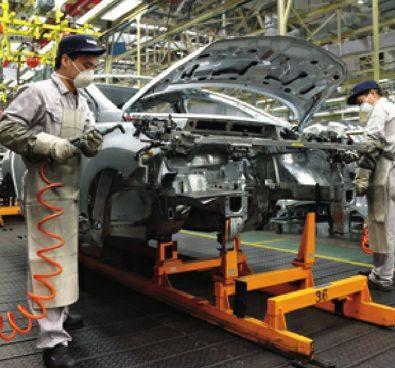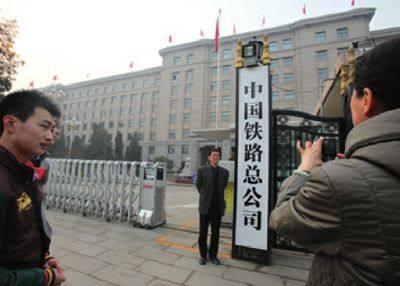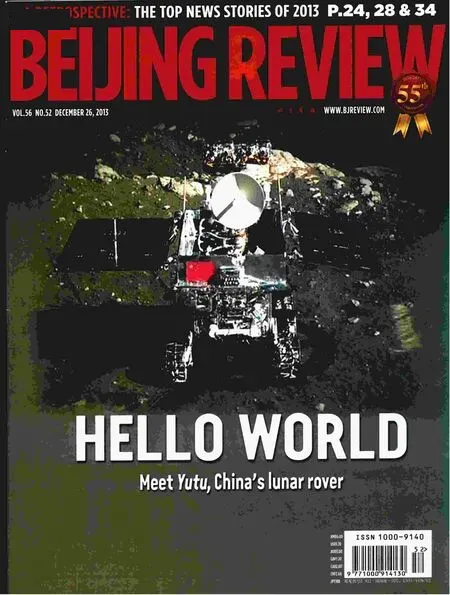Top 10 Economic News Stories in 2013
2013-04-29
Stable Economic Growth
Chinas economic growth is on track to meet its 7.5-percent growth target for the whole year. GDP growth accelerated to 7.8 percent in the third quarter, up from 7.7 percent in the first quarter and 7.5 percent in the second. In the first three quarters, GDP growth reached 7.7 percent.
In the first 11 months, the consumer price index rose 2.6 percent year on year, well below the governments full-year target of 3.5 percent.
The unemployment rate was 4.04 percent for the first three quarters, dropping for the first time in three years and well below the full-year limit of 4.6 percent. China created new jobs for 10.66 million urban residents from January to September, already exceeding the target of 9 million for the year.
Chinas total grain output reached 601.94 million tons in 2013, up 2.1 percent year on year, marking an increase for 10 consecutive years.
The Central Economic Work Conference held from December 10 to 13 in Beijing made plain that making progress while ensuring stability will be the keynote in 2014 and that China will continue to follow a proactive fiscal policy and a prudent monetary policy next year.
Shanghai Free Trade Zone
In August, the State Council approved the establishment of a pilot free trade zone (FTZ) in Shanghai, as a testing ground for the country to further open up its economy and accelerate the transformation of government functions.
The Shanghai FTZ was officially launched on September 29. Covering an area of 28.78 square km, it will be built on the basis of Shanghais existing bonded zones—Waigaoqiao Free Trade Zone, Waigaoqiao Free Trade Logistics Park, Yangshan Free Trade Port Area and Pudong Airport Comprehensive Free Trade Zone—and will take more than 10 years to complete.
On December 2, the Peoples Bank of China announced detailed reform guidelines to support the Shanghai FTZ. The financial package includes 30 detailed instructions which involve promoting capital account convertibility, expanding cross-border use of the yuan and interest rate liberalization.
Financial and Taxation Reforms
The Peoples Bank of China removed controls on lending rates on July 20, and financial institutions can now independently decide lending rates in accordance with business principles.
As of December 9, a new guidelines on deposit certificates in the interbank market became effective. The guideline will help increase the range of debt products offered by financial institutions.
Following regional experiments since the beginning of 2012, China rolled out its pilot program to replace turnover tax with value-added tax throughout the country on August 1.
Internet Finance Takes Off
Alibaba Group, Chinas e-commerce giant, launched an online-finance platform in July through Alipay, Alibabas third-party-payment arm, to deposit idle Alipay funds into a comparatively high-yielding money market fund.
Given Yuebaos current annual interest rate of around 5 percent, its lack of a minimum deposit requirement, and the ability to transfer and withdraw funds easily without paying commission, Yuebao had attracted more than 100 billion yuan ($16.5 billion) in deposits by November 14.
Many other Internet companies, such as search engine giant Baidu and Suning.com, launched similar products.
The boom in Internet finance is partly fueled by skyrocketing e-commerce in the country.
On November 11, dubbed Singles Day due to its date reading 11/11, Alibaba beat its previous single-day sales record. Its business-to-customer website Tmall and customer-to-customer website Taobao raked in a total of 35.02 billion yuan ($5.75 billion) within 24 hours.
Real Estate Regulation
China issued an array of regulations this year in attempts to cool the heated housing market.
Home prices took an upward swing since the last quarter of 2012 despite governmentimposed measures to cool the market. In light of this, the State Council unveiled five new policies in February to reaffirm its stance on further regulating the housing market. The five measures include improving local governments accountability in stabilizing housing prices, strictly curbing speculation in the housing market, ensuring land supply, boosting the construction of government-subsidized housing for low-income households and intensifying housing market supervision. In March, a 20-percent capital gains tax on secondhand home purchases was imposed to cool the market.
On November 20, the State Council decided to integrate the responsibilities of realty registration into one department and establish a single information-sharing platform, a move believed to be able to help combat corruption and surging high housing prices.
New Stock Market Policies
The China Securities Regulatory Commission on November 30 released four documents on regulating the stock markets, including measures for market-based change in the initial public offering (IPO) issuance mechanism, preferred shares, better protection for investor interests in cash dividends and stricter scrutiny of backdoor listing. The securities watchdog promised to streamline the IPO approval process while strengthening supervision over listed companies.
On December 14, the State Council announced that the overthe-counter market, a national share transfer system for small and medium-sized enterprises, also known as the New Third Board, will be expanded to cover all innovative and promising companies. Qualified companies can apply for listing on the board for public share transfer so as to realize equity and bond financing as well as asset restructuring.
Overseas Investment Boom
Chinese outbound investment rose a dramatic 28.3 percent in the first 11 months of the year as the worlds second largest economy acquired foreign assets amid its growing global economic clout.
In February, China National Offshore Oil Corp. Ltd. completed the countrys largest overseas takeover by acquiring Canadian oil and gas company Nexen for $15.1 billion.
In October, Shuanghui International Holdings Ltd., Chinas largest meat producer, acquired U.S. pork giant Smithfield Foods Inc. for $7.1 billion, the largest acquisition of an American firm by a Chinese one.
Outbound investment, calculated on the basis of deals closed, rose to $80.2 billion during the January-November period, exceeding the $77.2 billion for all of last year, according to the Ministry of Commerce.
Despite surging figures, Chinese companies are frequently excluded from overseas markets.
On January 31, the U.S. International Trade Commission (USITC) initiated a Section 337 investigation into wireless devices from four communications companies, including Huawei and ZTE, for patent infringement. In July, the USITC also announced a Section 337 investigation into Sany Heavy Industry, the largest machinery manufacturer in China, and its American branch for patent infringement.
Trade Disputes
As China becomes a major power, the country has been targeted in trade spats more frequently. From January to November, the number of trade disputes targeting China reached 80, up 12 percent year on year.
China and the European Union(EU) were mired in a tug of war over solar duties at one point.
After investigations lasting nearly a year, the European Commission declared the levying of a provisional anti-dumping duty of 11.8 percent on imports of solar panels, cells and wafers from China, from June 6 to August 6, and the duty was to be raised to 47.6 percent if a compromise was not reached between the two parties.
On July 27, five solar panel groups, including the China Chamber of Commerce for Import and Export of Machinery and Electronic Products, announced that an agreement had been reached to allow Chinese solar panel imports access to the majority of the EU market at a minimum set price.
Monosodium glutamate, a flavor enhancer, has been the latest target in Chinas ongoing trade battles. On October 24, the U.S. Department of Commerce announced an anti-dumping and countervailing investigation into imports of MSG from China.
Meanwhile, Chinas Ministry of Commerce began an anti-dumping and anti-subsidy investigation into wines imported from the EU on June 5. It also initiated anti-dumping duties against imports of toluidine originating from the EU as of June 28.
Reducing Overcapacity
The Chinese Government has vowed to tackle the thorny issue of overcapacity that plagues certain industries, and has greatly hindered economic development, posing a severe challenge to the natural environment.
On October 15, the State Council issued the Guidelines to Tackle Serious Production Overcapacity, which listed five sectors with particularly pressing overcapacity problems—cement, electrolytic aluminum, sheet glass, shipping and steel—and claiming that such excess would lead to a drop in revenues and mounting risks. The State Council required related ministries and commissions to formulate detailed measures.
As a result, on November 13, the Ministry of Industry and Information Technology issued a document on thresholds for the shipbuilding industry, putting forward specific requirements for production facilities, equipment, measurement and detection, construction technical capacity, technology innovation, quality assurance system, energy conservation, and environmental protection. Enterprises that fail to meet these requirements will be shut down.
The Ministry of Land and Resources announced on November 15 it would strengthen control of land resource development and stop approval of land use for projects in the steel, cement, electrolytic aluminum, sheet glass and shipbuilding industries with serious surplus capacity. No land will be granted for increased capacity for already existing projects in these industries.
MOR Dismantled
Railway reform took another big step this year when government functions were separated from enterprises operations in the sector.
The Ministry of Railways (MOR) had long been at the center of controversy for being both a policymaker and a service provider and been criticized for its bureaucracy, low efficiency and poor services.
In March, the MOR was broken up into administrative and commercial arms—namely the National Railway Administration under the Ministry of Transport and the China Railway Corp.
More changes are still to come. On August 19, the State Council published detailed plans to innovate railway funding and speed up construction. Private investment is to be encouraged.
